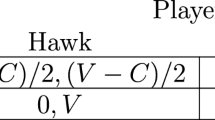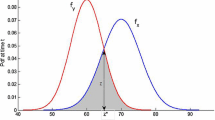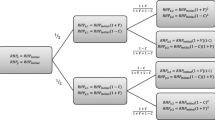Abstract
Societies are considered in which a non-transitive dominance relation exists between every pair of members, such as the peck-right in a flock of hens. A one-dimensional measure of the structure of such a society,h, is defined, withh=0 for equality andh=1 for the hierarchy. It is assumed that each member of the society is characterized by an ability vector whose components depend on individual characteristics such as size, concentration of sex hormone, etc., but not on social factors such as social rank. The distribution of abilities among members of the society is assumed to be given by a distribution function which is the same for all members, and the probability that one member dominates another is given by a function of the ability vectors of the two.
On these assumptions formulas for the expected (mean) value and variance ofh are determined in terms of the distribution and dominance probability functions. Some special cases are calculated, especially that for normany distributed abilities and dominance probability given by the normal probability integral.
Several conclusions are derived. If all members are of equal ability, so that dominance probability is 1/2, then any sizable society is much more likely to be near the equality than the hierarchy; and, as the size of the society increases, the probability that it will be near the hierarchy becomes vanishingly small. If the dominance probability is a weighted sum of several independent components, which make up the ability vector, then the society is less likely to be close to the hierarchy as the number of these components increases. The hierarchy is the prevalent structure only if unreasonably small differences in ability are decisive for dominance. From this it appears that the social factors, or psychological factors such as the previous history of dominance, which are not included in the present treatment, may be of great importance in explaining the observed prevalence of structures very close to the hierarchy in flocks of domestic hens.
Similar content being viewed by others
Literature
Allee, W. C. 1938.The Social Life of Animals. New York: W. W. Norton.
— et al. 1949.Animal Ecology. Philadelphia: W. B. Saunders.
Cramér, H. 1946.Mathematical Methods of Statistics. Princeton: Princeton University Press.
Collias, N. E. 1943. “Statistical factors which make for success in initial encounters between hens.”Amer. Naturalist,77, 519–38.
Guhl, A. M. and W. C. Allee. 1944. “Some measurable effects of social organization in flocks of hens.”Physiol. Zool.,17, 320–47.
Koopmans, T. C. and O. Reiersøl. 1950. “The identification of structural characteristics.”Ann. Math. Stat.,21, 165–81.
Landau, H. G. 1950. “Note on the Effect of Imitation in Social Behavior.”Bull. Math. Biophysics,12, 221–35.
Lienau, C. C. 1947. “Quantitative aspects of organization.”Human Biol.,19, 163–216.
von Neumann, J. and O. Morgenstern. 1947.Theory of Games and Economic Behavior. 2nd ed. Princeton: Princeton University Press.
Pearson, K. 1909. “On a new method of determining correlation between a measured characterA, and a characterB, of which only the percentage of cases whereinB exceeds (or falls short of) a given intensity is recorded for each grade ofA.”Biometrika,7, 96–105.
Potter, J. H. 1949. “Dominance relations between different breeds of domestic hens.”Physiol. Zool.,22, 261–80.
Rapoport, A. 1949a. “Outline of a Probabilistic Approach to Animal Sociology: I.”Bull. Math. Biophysics,11, 183–96.
— 1949b. “Outline of a Probabilistic Approach to Animal Sociology: II.”Ibid.,11, 273–81.
— 1950. “Outline of a Probabilistic Approach to Animal Sociology: III.”Ibid.,12, 7–17.
Schjelderup-Ebbe, T. 1922. “Bieträge zum Sozialpsychologie des Haushuhns.”Zeit. für Psychologie,88, 225–52.
Author information
Authors and Affiliations
Rights and permissions
About this article
Cite this article
Landau, H.G. On dominance relations and the structure of animal societies: I. Effect of inherent characteristics. Bulletin of Mathematical Biophysics 13, 1–19 (1951). https://doi.org/10.1007/BF02478336
Issue Date:
DOI: https://doi.org/10.1007/BF02478336




